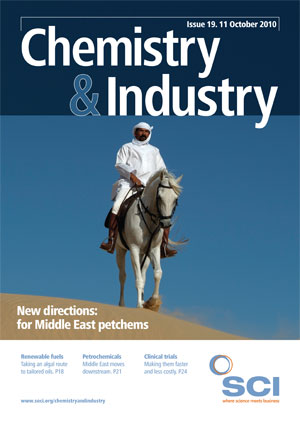Millions of products contain oils derived from petroleum and plant oils, including plastics, cosmetics, detergents and cleaners and fuels. However, growing global consumption of products made from petroleum and natural oils like palm oil is causing significant problems, including climate change, deforestation and natural resource depletion. The world supply of oil and natural oils is struggling to keep pace with demand, resulting in increased pricing that affects the entire economy and brings the world closer to potentially irreversible climate change.
At US-based Solazyme, we have developed an alternative route to developing oil and products derived from oil such as fuels by harnessing the natural oil-production capabilities of algae. Today, we have used this technology to manufacture more non-alcohol fuel than any other company in the world. And because the process does not directly rely on photosynthesis and uses virtually any feedstock, production facilities can be built anywhere in the world without time constraints on production.
Unlike other microorganisms such as brewer’s yeast and bacteria, algae are incredibly efficient oil producers, with natural lipid metabolic processes capable of producing cells containing more than 70% of oil by mass. It is with this technology that we have been able to manufacture over 50,000 gallons of oil thus far in 2010 and hundreds of tons of biomaterials that are tailored not only for biofuel production, but also as replacements for fossil petroleum in the manufacture of thousands of products, such as plastics, chemicals and lubricants.
Additionally, we have developed a unique cellulosic algae fermentation production process, which allows the technology platform to adapt to supplies of cellulosic sugars in development. Solazyme has already produced laboratory scale quantities of oil from multiple cellulosic feedstocks, including switchgrass, miscanthus, sugar beet pulp, corn stover and sugarcane bagasse, and has identified a number of algae strains that grow on these. We can manufacture oil using all of the same feedstocks used to manufacture cellulosic ethanol, and use them to make fuels that are far higher in energy density than alcohol fuels such as ethanol and butanol; 100% infrastructure compatible (unlike alcohol fuels); do not face a blend wall (unlike alcohol fuels); and have a superior energy in: energy out ratio than alcohol fuels because there is no distillation step needed to purify the end product.
About 87% of global arable land is currently used to produce carbohydrate crops, while the balance is used to produce oil crops, such as soya bean and palm. Solazyme has essentially developed a way to convert fermentable sugars including cellulosics into oil for fuel and for food. The process is scalable; uses standard industrial fermentation equipment; and is able to produce in a matter of days, high-value, functional oils from renewable resources that can be used across a variety of industries and applications including fuels, food, cosmetics, health and wellness and chemicals.
So how did all of these technology developments originally come about? I first began to explore the concept of algae for biofuels as a PhD student in genetics in the mid-1990s, but saw no clear route for how to execute scientifically on the concept. It wasn’t until 2001, while reading the human genome issue of Nature (2001, 409, 745), that I began to appreciate how that could be done by considering the parallels between the methodology for high throughput human genomics and engineering algae for maximal biofuel production. I realised that the biotechnology toolkits developed to map the human genome could be applied to put algae to work to make biofuels. Up until that point, algae had represented a diverse, poorly understood, under-utilised natural resource because the biotech tools needed to exploit them to make biofuels did not exist.
In 2003, after about nine years of discussion and planning with my best friend from college, Jonathan Wolfson, the concepts we had mulled over were finally ready to become a reality. In a nutshell, we believed that we had figured out how to take a 150myear process for making crude oil from plants and condense it to a matter of days. Shortly thereafter, Jonathan relocated from New York to California and we founded Solazyme in my Palo Alto garage.
We originally grew algae in ponds and photobioreactors, as do most other algal biofuel firms, but quickly discovered that the costs of this direct photosynthetic process were prohibitive, producing oil at a cost of over $1000/gallon. However, the real breakthrough came two years later when we switched to ‘heterotrophic’ fermentation of algae in the dark, by feeding them carbohydrate feedstocks, such as sugar cane or cellulosic biomass. Algal fermentation is far cheaper than photosynthesis as the algae grow much faster, yielding orders of magnitude more biomass per litre, and produce a far higher percentage of oil per cell.
We have been performing this algal fermentation process in commercial scale fermentors for almost three years, and in the next 18 months we believe that we will be able to manufacture oil at a cost of $60-80/ barrel, making it highly competitive with petroleum.
Diversification strategy
We realised early on in the company’s development that we should think about our technology as a platform for making oils, not fuels. Most oil-based products are made from a relatively small number of oils that are available at high volume and commodity cost: petroleum, palm, soya bean, canola and others. Our genetic engineering capabilities allow us to make designer oils by altering the metabolic pathways for oil production. This has resulted in the creation of a large library of oils that our commercial partners can choose from, whether they make diesel fuel, jet fuel, plastics, soap, detergents, and other products.
Importantly, these designer oils can be made from any carbohydrate feedstock such as sugar cane, glycerol, and cellulose, and the infrastructure needed to deploy the technology already exists and is quite well developed.
Solazyme has delivered the largest supply of nonalcohol microbial fuel in the world to the US Navy for testing with its fleet of ships and jets – a drop-in replacement hydrocarbon diesel and jet fuel that is essentially chemically indistinguishable from what comes out of the pump at the gas station. We have made other tailored oils suited for making soaps and detergents; and oils that mimic naturally occurring oils such as tallow. Food research has led to distribution partnerships and testing in products such as baked goods, sauces, beverages and meal supplements. Food and anti-ageing skin care products containing our algal oil ingredients are already available on the market today, while research in chemicals has led to a significant R&D agreement with consumer goods giant Unilever. The result is that we have generated revenue in all business units starting in 2009 – fuels and chemicals, food, and cosmetics.

The sustainability of algal oil production processes, however, depends on the method of production. One has to take into account land use, water use, the energy in: energy out ratio, and other factors of a production process to assess sustainability. In 2009, Solazyme underwent a study conducted by the Life Cycle Associates, using the Argonne National Laboratories GREET model. Through this analysis, LCA concluded that the full lifecycle greenhouse gas (GHG) emissions from ‘field-to-wheels’ for Solazyme's algal biofuel, Soladiesel, are 85 to 93% lower than standard petroleum based ultra-low sulfur diesel (ULSD). The analysis also revealed that our advanced biofuels result in a significantly lower carbon footprint than any currently available first-generation biofuel.
Infrastructure compatibility
The compatibility of our process with existing infrastructure has allowed us to scale up production by over 10,000-fold without any loss in productivity. Commercial scale fermentation facilities have been in operation for almost three years, mainly for demonstration purposes and for manufacturing oil to make fuel for partners such as the US military. A purpose-built facility would be capable producing roughly 75-100m gallons of oil/year.
The feasibility of using algae to make oil for fuels and other products depends on the production method. In a direct photosynthetic system, making oil is a two step process. In the first step photons are used to drive the process of fixing carbon from carbon dioxide into sugars inside the cell. In the second step these sugars are converted to oil. While the conversion of sugar into oil is extremely efficient in algae, the first step is extremely inefficient in a large population of algae such as a pond; in fact a dense pond of algae is far less efficient at using photons than a field of sugar cane. Under high sunlight, about 95% of the energy from photons absorbed by algae are dissipated as heat rather than used by the cells.
Instead, our approach is to integrate the extremely efficient capability of plants, such as sugar cane, to turn photons into sugar with the extremely efficient capability of algae to turn sugar into oil. The resulting oil is far more energy dense and infrastructure compatible than other processes of converting sugar, such as ethanol production. And because our algae feed on a wide variety of plants that recycle carbon from the atmosphere, the whole process has a low ‘carbon footprint’; is non-polluting and energyefficient, using resources that do not compete with food crops for arable land and water supply. Our fermentation process requires less energy, land, and water than other processes used to produce biofuels.
Another advantage of Solazyme’s algae platform, recognised by the US Department of Defense, is energy security. Using secure, domestically produced feedstocks such as cellulose and sugar cane, we can take part or all of the fuel supply to major US military bases off the global petroleum supply chain. This would allow the bases to function uninterrupted even during major disruptions in petroleum supply due to hurricanes, geopolitical events, terrorism, and the frightening combination of more than one factor simultaneously. Using the amount of cellulosic feedstocks available in the US today as calculated in the US Department of Energy’s Billion Ton Study (http://www1.eere.energy. gov/biomass/pdfs/final_billionton_vision_report2.pdf), our process could produce over 65bn gallons of oil/ year – over 20% of US oil consumption.
The performance of our oils is superior to petroleum in a number of ways. First, petroleum is cracked to achieve the desired chain length. This process results in yield losses, which increase the cost of making products and creates unwanted/low value byproducts, such as propane. Oils entering the refinery with the perfect chain length can produce much higher yields. Another advantage is the high purity of our oil. A typical barrel of petroleum contains heavy materials with a high carbon to hydrogen ratio, such as asphaletenes and other impurities that are expensive to remove. Our fuel oil is over 98% pure triglyceride and is extremely low in metals and other catalyst-killing impurities such as phosphorus and sulfur (<5ppm) when it enters the refinery. Furthermore, because our process produces the same oil composition every time we use a given algae strain, refineries do not need to adapt to the changing composition of incoming oil the way they do with petroleum coming from different oil fields around the world.
The adaptability of our algae to use a wide range of non-food carbon feedstocks improves scalability while stabilising costs. As a result, we believe the technology has lower technical risk than competing second generation biofuels, a shorter timeline to commercialisation, and a better fit to existing infrastructure.
Harrison Dillon is co-founder, president and chief technology officer at Solazyme, based in South San Francisco, California, US.





